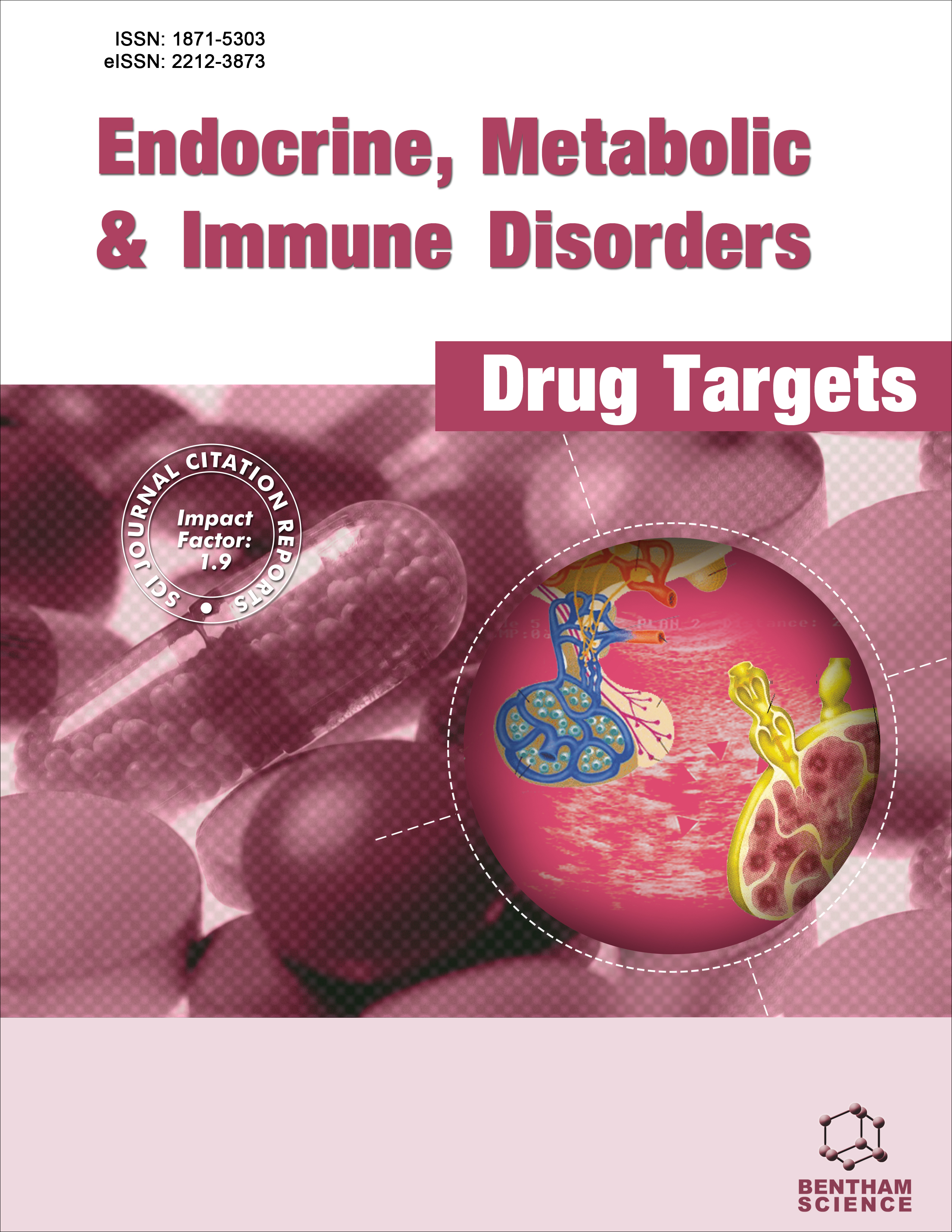- Home
- A-Z Publications
- Endocrine, Metabolic & Immune Disorders-Drug Targets (Formerly Current Drug Targets - Immune, Endocrine & Metabolic Disorders)
- Previous Issues
- Volume 9, Issue 4, 2009
Endocrine, Metabolic & Immune Disorders-Drug Targets (Formerly Current Drug Targets - Immune, Endocrine & Metabolic Disorders) - Volume 9, Issue 4, 2009
Volume 9, Issue 4, 2009
-
-
Immune Cell Entry to Central Nervous System - Current Understanding and Prospective Therapeutic Targets
More LessAuthors: Catriona T. Prendergast and Stephen M. AndertonUnder normal physiological conditions there is minimal entry of immune cells into the central nervous system (CNS) for the purpose of immune surveillance. During inflammation, however, extensive infiltration of immune cells can lead to the induction of CNS autoimmune disease, for example multiple sclerosis (MS) and its animal model experimental autoimmune encephalomyelitis (EAE). The barriers that regulate cell Read More
-
-
-
Dendritic Cells for Active Anti-Cancer Immunotherapy: Targeting Activation Pathways Through Genetic Modification
More LessAuthors: Karine Breckpot and David EscorsTumour immunotherapy has become a treatment modality for cancer, harnessing the immune system to recognize and eradicate tumour cells specifically. It is based on the expression of tumour associated antigens (TAA) by the tumour cells and aims at the induction of TAA-specific effector T cell responses, whilst overruling various mechanisms that can hamper the anti-tumour immune response, e.g. regulatory T cells (Treg) Read More
-
-
-
MHC Class I TCR Engineered Anti-Tumor CD4 T Cells: Implications For Cancer Immunotherapy
More LessT cell immunity is critical for a protective immune response against cancers. Traditionally, this function has been ascribed to CD8 T lymphocytes with cytotoxic activity, which are restricted by MHC class I molecules. The lack of direct cytolytic effector function on part of CD4 T cells, which are MHC class II restricted, coupled with the MHC class II negative nature of most human cancers have been the main reasons for CD8 cent Read More
-
-
-
Interleukin-24: A Molecule with Potential Anti-Cancer Activity and a Cytokine in Search of a Function
More LessAuthors: Ali Dalloul and Alexander Sainz-PerezThe gene encoding Melanoma-differentiation antigen-7 (MDA-7) was discovered more than 10 years ago. Its potential anti-cancer activity was surmised because its expression is inversely correlated with the cell proliferation status. Indeed adenoviral delivery of this gene proved to be efficient in killing several cancer cell lines and great strides have been made concerning its molecular ways of action. Later it was shown Read More
-
-
-
Synergistic Activation of Leukocytes by Bacterial Chemoattractants: Potential Drug Targets
More LessAuthors: Ling-Yu Chen and Zhixing K. PanAccumulating evidence demonstrates that bacterial chemoattractants not only attract leukocytes (chemotaxis) but also contribute directly to inflammation by activation of leukocytes to produce a variety of pro-inflammatory cytokines. Recent studies have shown that mixtures of the bacterial chemoattractant fMLP (N-formyl-Met-Leu-Phe) and other bacterial products/components such as LPS (lipopolysaccharide) beh Read More
-
-
-
Future Developments in Osteoporosis Therapy
More LessBy K. W. NgAnti-resorptives that prevent osteoclasts from resorbing bone are the mainstay of treatment for osteoporosis, while parathyroid hormone is the only agent available that stimulates osteoblasts to form bone. Advances in knowledge about metabolic pathways in bone cell biology have identified specific points of intervention whereby formation and function of osteoclasts and osteoblasts can be inhibited or stimulated. The next ge Read More
-
-
-
Pleiotropic Effects of Cathepsin D
More LessAuthors: Aruna Vashishta, Sujata S. Ohri and Vaclav VetvickaOver the past decades, the paradigm that lysosomal enzymes participate only in non-specific protein degradation during cell death has changed. Studies conducted both in cell cultures and in animals defined the role of these enzymes that includes cathepsin D (CD). Knockout mice revealed the role of CD in postnatal tissue homeostasis and remodeling. Mutations that abolish the CD enzymatic activity have been implicated in Read More
-
-
-
A Current Update on the Use of Alpha Lipoic Acid in the Management of Type 2 Diabetes Mellitus
More LessType 2 Diabetes Mellitus (T2DM) which is characterised by insulin resistance, is closely linked to the triad of glucolipotoxicity, inflammation and oxidative stress. Increased adiposity, leading to increased free fatty acids (FFAs), contributes to insulin resistance by disrupting the signal transduction pathway of insulin mediated glucose disposal, and causes impaired insulin secretion. Hyperglycaemia and dyslipidaemia dri Read More
-
Volumes & issues
-
Volume 25 (2025)
-
Volume 24 (2024)
-
Volume 23 (2023)
-
Volume 22 (2022)
-
Volume 21 (2021)
-
Volume 20 (2020)
-
Volume 19 (2019)
-
Volume 18 (2018)
-
Volume 17 (2017)
-
Volume 16 (2016)
-
Volume 15 (2015)
-
Volume 14 (2014)
-
Volume 13 (2013)
-
Volume 12 (2012)
-
Volume 11 (2011)
-
Volume 10 (2010)
-
Volume 9 (2009)
-
Volume 8 (2008)
-
Volume 7 (2007)
-
Volume 6 (2006)
Most Read This Month
Article
content/journals/emiddt
Journal
10
5
false
en


